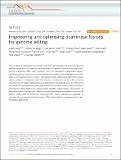| dc.contributor.author | Yang, Luhan | |
| dc.contributor.author | Briggs, Adrian W. | |
| dc.contributor.author | Chew, Wei Leong | |
| dc.contributor.author | Mali, Prashant | |
| dc.contributor.author | Guell, Marc | |
| dc.contributor.author | Aach, John | |
| dc.contributor.author | Kan, Yinan | |
| dc.contributor.author | Lesha, Emal | |
| dc.contributor.author | Soundararajan, Venkataramanan | |
| dc.contributor.author | Goodman, Daniel Bryan | |
| dc.contributor.author | Cox, David | |
| dc.contributor.author | Church, George M | |
| dc.contributor.author | Zhang, Feng | |
| dc.date.accessioned | 2017-03-28T17:44:33Z | |
| dc.date.available | 2017-03-28T17:44:33Z | |
| dc.date.issued | 2016-11 | |
| dc.date.submitted | 2016-05 | |
| dc.identifier.issn | 2041-1723 | |
| dc.identifier.uri | http://hdl.handle.net/1721.1/107758 | |
| dc.description.abstract | Precise editing is essential for biomedical research and gene therapy. Yet, homology-directed genome modification is limited by the requirements for genomic lesions, homology donors and the endogenous DNA repair machinery. Here we engineered programmable cytidine deaminases and test if we could introduce site-specific cytidine to thymidine transitions in the absence of targeted genomic lesions. Our programmable deaminases effectively convert specific cytidines to thymidines with 13% efficiency in Escherichia coli and 2.5% in human cells. However, off-target deaminations were detected more than 150 bp away from the target site. Moreover, whole genome sequencing revealed that edited bacterial cells did not harbour chromosomal abnormalities but demonstrated elevated global cytidine deamination at deaminase intrinsic binding sites. Therefore programmable deaminases represent a promising genome editing tool in prokaryotes and eukaryotes. Future engineering is required to overcome the processivity and the intrinsic DNA binding affinity of deaminases for safer therapeutic applications. | en_US |
| dc.language.iso | en_US | |
| dc.publisher | Nature Publishing Group | en_US |
| dc.relation.isversionof | http://dx.doi.org/10.1038/ncomms13330 | en_US |
| dc.rights | Creative Commons Attribution 4.0 International License | en_US |
| dc.rights.uri | http://creativecommons.org/licenses/by/4.0/ | en_US |
| dc.source | Nature | en_US |
| dc.title | Engineering and optimising deaminase fusions for genome editing | en_US |
| dc.type | Article | en_US |
| dc.identifier.citation | Yang, Luhan et al. “Engineering and Optimising Deaminase Fusions for Genome Editing.” Nature Communications 7 (2016): 13330. | en_US |
| dc.contributor.department | Harvard University--MIT Division of Health Sciences and Technology | en_US |
| dc.contributor.department | Massachusetts Institute of Technology. Department of Brain and Cognitive Sciences | en_US |
| dc.contributor.department | McGovern Institute for Brain Research at MIT | en_US |
| dc.contributor.department | Program in Media Arts and Sciences (Massachusetts Institute of Technology) | en_US |
| dc.contributor.mitauthor | Goodman, Daniel Bryan | |
| dc.contributor.mitauthor | Cox, David | |
| dc.contributor.mitauthor | Church, George M | |
| dc.contributor.mitauthor | Zhang, Feng | |
| dc.relation.journal | Nature Communications | en_US |
| dc.eprint.version | Final published version | en_US |
| dc.type.uri | http://purl.org/eprint/type/JournalArticle | en_US |
| eprint.status | http://purl.org/eprint/status/PeerReviewed | en_US |
| dspace.orderedauthors | Yang, Luhan; Briggs, Adrian W.; Chew, Wei Leong; Mali, Prashant; Guell, Marc; Aach, John; Goodman, Daniel Bryan; Cox, David; Kan, Yinan; Lesha, Emal; Soundararajan, Venkataramanan; Zhang, Feng; Church, George | en_US |
| dspace.embargo.terms | N | en_US |
| dc.identifier.orcid | https://orcid.org/0000-0003-3759-6883 | |
| dc.identifier.orcid | https://orcid.org/0000-0003-2782-2509 | |
| mit.license | PUBLISHER_CC | en_US |
